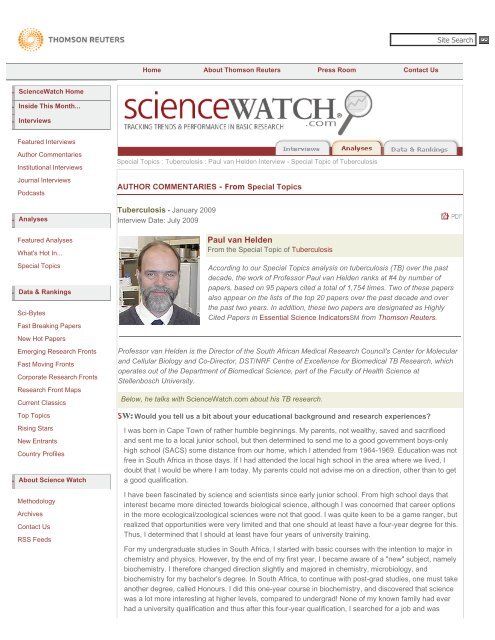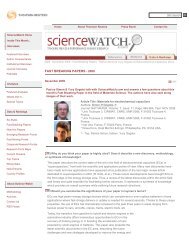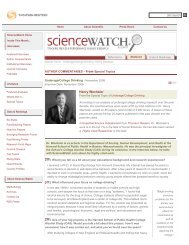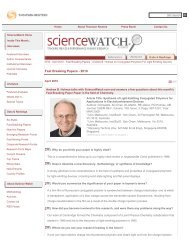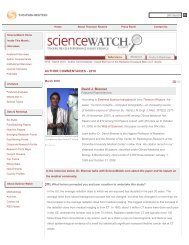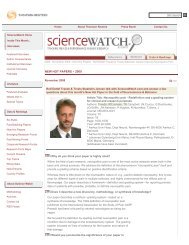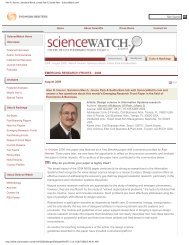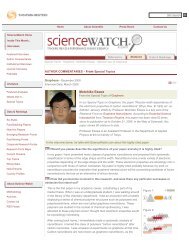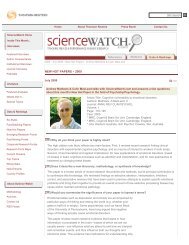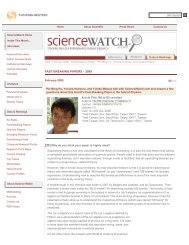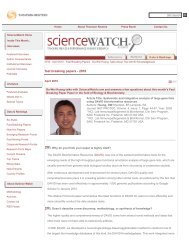Paul van Helden Interview - Special Topic of Tuberculosis ...
Paul van Helden Interview - Special Topic of Tuberculosis ...
Paul van Helden Interview - Special Topic of Tuberculosis ...
Create successful ePaper yourself
Turn your PDF publications into a flip-book with our unique Google optimized e-Paper software.
Home About Thomson Reuters Press Room Contact Us<br />
●<br />
●<br />
●<br />
ScienceWatch Home<br />
Inside This Month...<br />
<strong>Interview</strong>s<br />
Featured <strong>Interview</strong>s<br />
Author Commentaries<br />
Institutional <strong>Interview</strong>s<br />
Journal <strong>Interview</strong>s<br />
Podcasts<br />
<strong>Special</strong> <strong>Topic</strong>s : <strong>Tuberculosis</strong> : <strong>Paul</strong> <strong>van</strong> <strong>Helden</strong> <strong>Interview</strong> - <strong>Special</strong> <strong>Topic</strong> <strong>of</strong> <strong>Tuberculosis</strong><br />
AUTHOR COMMENTARIES - From <strong>Special</strong> <strong>Topic</strong>s<br />
●<br />
Analyses<br />
<strong>Tuberculosis</strong> - January 2009<br />
<strong>Interview</strong> Date: July 2009<br />
●<br />
●<br />
Featured Analyses<br />
What's Hot In...<br />
<strong>Special</strong> <strong>Topic</strong>s<br />
Data & Rankings<br />
Sci-Bytes<br />
Fast Breaking Papers<br />
New Hot Papers<br />
Emerging Research Fronts<br />
Fast Moving Fronts<br />
Corporate Research Fronts<br />
Research Front Maps<br />
Current Classics<br />
Top <strong>Topic</strong>s<br />
Rising Stars<br />
New Entrants<br />
Country Pr<strong>of</strong>iles<br />
About Science Watch<br />
Methodology<br />
Archives<br />
Contact Us<br />
RSS Feeds<br />
<strong>Paul</strong> <strong>van</strong> <strong>Helden</strong><br />
From the <strong>Special</strong> <strong>Topic</strong> <strong>of</strong> <strong>Tuberculosis</strong><br />
According to our <strong>Special</strong> <strong>Topic</strong>s analysis on tuberculosis (TB) over the past<br />
decade, the work <strong>of</strong> Pr<strong>of</strong>essor <strong>Paul</strong> <strong>van</strong> <strong>Helden</strong> ranks at #4 by number <strong>of</strong><br />
papers, based on 95 papers cited a total <strong>of</strong> 1,754 times. Two <strong>of</strong> these papers<br />
also appear on the lists <strong>of</strong> the top 20 papers over the past decade and over<br />
the past two years. In addition, these two papers are designated as Highly<br />
Cited Papers in Essential Science IndicatorsSM from Thomson Reuters.<br />
Pr<strong>of</strong>essor <strong>van</strong> <strong>Helden</strong> is the Director <strong>of</strong> the South African Medical Research Council's Center for Molecular<br />
and Cellular Biology and Co-Director, DST/NRF Centre <strong>of</strong> Excellence for Biomedical TB Research, which<br />
operates out <strong>of</strong> the Department <strong>of</strong> Biomedical Science, part <strong>of</strong> the Faculty <strong>of</strong> Health Science at<br />
Stellenbosch University.<br />
Below, he talks with ScienceWatch.com about his TB research.<br />
Would you tell us a bit about your educational background and research experiences?<br />
I was born in Cape Town <strong>of</strong> rather humble beginnings. My parents, not wealthy, saved and sacrificed<br />
and sent me to a local junior school, but then determined to send me to a good government boys-only<br />
high school (SACS) some distance from our home, which I attended from 1964-1969. Education was not<br />
free in South Africa in those days. If I had attended the local high school in the area where we lived, I<br />
doubt that I would be where I am today. My parents could not advise me on a direction, other than to get<br />
a good qualification.<br />
I have been fascinated by science and scientists since early junior school. From high school days that<br />
interest became more directed towards biological science, although I was concerned that career options<br />
in the more ecological/zoological sciences were not that good. I was quite keen to be a game ranger, but<br />
realized that opportunities were very limited and that one should at least have a four-year degree for this.<br />
Thus, I determined that I should at least have four years <strong>of</strong> university training.<br />
For my undergraduate studies in South Africa, I started with basic courses with the intention to major in<br />
chemistry and physics. However, by the end <strong>of</strong> my first year, I became aware <strong>of</strong> a "new" subject, namely<br />
biochemistry. I therefore changed direction slightly and majored in chemistry, microbiology, and<br />
biochemistry for my bachelor's degree. In South Africa, to continue with post-grad studies, one must take<br />
another degree, called Honours. I did this one-year course in biochemistry, and discovered that science<br />
was a lot more interesting at higher levels, compared to undergrad! None <strong>of</strong> my known family had ever<br />
had a university qualification and thus after this four-year qualification, I searched for a job and was
<strong>of</strong>fered one as a QC chemist in a local municipality.<br />
On the way home from my interview and job <strong>of</strong>fer and just<br />
before I signed acceptance, I stopped over at my university<br />
teaching department and wandered into the pr<strong>of</strong>essor's <strong>of</strong>fice to<br />
tell him what I had decided to do. He (Pr<strong>of</strong>. Claus von Holt) told<br />
me that I had more in me than that and that if I would change<br />
my mind, he would accept me as a Ph.D. student. I went home<br />
to discuss this with my parents, who were not particularly<br />
pleased with this turn <strong>of</strong> events. I think their reaction is easy to<br />
understand with the wisdom <strong>of</strong> hindsight. They grew up in the<br />
Depression years and my father was a soldier in WWII for six<br />
years, returning home with nothing. Turning down a "good" job<br />
<strong>of</strong>fer was just not in their realm <strong>of</strong> thinking. Fortunately, I<br />
decided that research was more interesting than being a QC<br />
chemist. So, I went back to being a student and completed my<br />
Ph.D. in protein (histone) sequencing at the end <strong>of</strong> 1978.<br />
After this, I accepted a job based in the Health Science Faculty<br />
<strong>of</strong> Stellenbosch University in Cape Town, where I have been<br />
ever since, with the exception <strong>of</strong> a post-doc period at the Roche<br />
Institute in New Jersey, USA, during 1981-2. This was an<br />
important experience, for while it did not equip me for the<br />
details <strong>of</strong> research projects back home in South Africa, my<br />
thinking was influenced, and learning new ways to do science,<br />
as well as learning new techniques and being exposed to a<br />
different culture was extremely important.<br />
This “PCR” instrument was developed<br />
in the lab <strong>of</strong> Pr<strong>of</strong>. <strong>Paul</strong> <strong>van</strong> <strong>Helden</strong> in<br />
1989. It was made entirely in-house<br />
and is based on 4 supermarket<br />
hairdryers. The “developers” are<br />
shown, from left to right: Pr<strong>of</strong>.<br />
Tommie Victor, Pr<strong>of</strong>. <strong>Paul</strong> <strong>van</strong><br />
<strong>Helden</strong>, Rene du Toit (Technologist),<br />
Frank Peiser (electronics), Cor<br />
Wijtenburg, (metal working).<br />
What influenced your decision to research tuberculosis?<br />
Being associated with—and later employed (1990) by—the South African Medical Research Council, I<br />
came into contact with scientists specializing in fields that I had never heard <strong>of</strong> as a molecular biologist/<br />
biochemist. These included fields such as epidemiology, health systems research, and the like. Some <strong>of</strong><br />
these people introduced me to concepts such as the "burden <strong>of</strong> disease."<br />
Since I was in a medical environment, I began to question what I was doing and what rele<strong>van</strong>ce it may<br />
have in a developing country. I began to think that we had some responsibility to use our limited finances<br />
carefully and to perhaps apply them to our most pressing problems. I gave thought to how we might do<br />
this, using new molecular biology tools. At that time, PCR had just recently hit the news and was the new<br />
kid on the block.<br />
Putting these thoughts together, I realized that TB was a major problem in South Africa and that the<br />
diagnostic test being used (microscopy smear) was essentially over 100 years old, and due for a<br />
change! Together with Pr<strong>of</strong>. Tommie Victor (my Ph.D. student at that time), we decided that we should<br />
try to investigate TB diagnosis by PCR from sputum. We could not afford to purchase any sophisticated<br />
equipment (there were all sorts <strong>of</strong> sanctions in place against South Africa at that time and our funding<br />
was very limited), so we got together with our electronics technician to see what we could do. Our<br />
electronics technician, Mr. Frank Peiser, is a real MacGyver type <strong>of</strong> person, and he soon built us what<br />
we think was the very first PCR instrument in Africa (see fig. 1). This was based on airflow from four<br />
domestic-quality hairdryers bought from a local supermarket! This instrument was the key to unlocking<br />
our new research and our first TB papers. It also meant that the lab used to get quite hot!<br />
One <strong>of</strong> your highly cited papers is the 1999 NEJM article, "Exogenous reinfection as a cause<br />
<strong>of</strong> recurrent tuberculosis after curative treatment" (<strong>van</strong> Rie A, et al., 341[16]: 1174-79, 14 October<br />
1999). Would you tell our readers a little bit about this paper—its goals and conclusions?<br />
At that time, and still today, people talk about "relapse" in TB. This is regarded to be the phenomenon<br />
seen when a patient is treated, appears to be cured, and then has a second or subsequent episode <strong>of</strong><br />
disease. The explanation for this was that some bacilli remained "hidden" within the patient, are not<br />
"killed" by treatment and at a later stage reactivate to cause disease.<br />
It seemed to us that this might not be the case, since with such a high incidence and prevalence rate, it<br />
was self-evident that individuals would be likely to be exposed to a source case multiple times in their<br />
lives. In addition, our people had been vaccinated by Bacille Calmette-Guérin and the high rates <strong>of</strong> TB<br />
suggested no protection from infection. We reasoned that if these ideas were true, then we could expect
to see different strain types in some patients experiencing a subsequent TB episode.<br />
By this time, we had quite some experience at using "fingerprinting" or genotyping and had a good<br />
collection <strong>of</strong> TB isolates from a high-incidence community available since 1993. This included a number<br />
<strong>of</strong> individuals who had had TB twice, after cure. We therefore looked at the strain types and noted that in<br />
the majority <strong>of</strong> cases subsequent episodes <strong>of</strong> TB were associated with a new strain type. The conclusion<br />
was simple: reinfection and not relapse was responsible for most cases <strong>of</strong> subsequent TB in our highincidence<br />
community, provided the patient was treated properly and had no other complicating illness, e.<br />
g., diabetes (patient compliant and not drug-resistant or HIV-positive).<br />
"...<br />
reinfection<br />
and not<br />
relapse was<br />
responsible<br />
for most<br />
cases <strong>of</strong><br />
subsequent<br />
TB in our<br />
highincidence<br />
community..."<br />
This paper was part <strong>of</strong> the Ph.D. work <strong>of</strong> Annelies <strong>van</strong> Rie, now a pr<strong>of</strong>essor herself in<br />
the USA. I recall some interesting experiences with this paper, one <strong>of</strong> which was<br />
arguing with the editorial staff at the NEJM about the usage <strong>of</strong> English, which<br />
illustrated the differences between UK and South African English and American<br />
English!<br />
A further thought regarding this result is that in these patients, an initial episode <strong>of</strong> TB<br />
is not protective. This can be the starting point <strong>of</strong> hours <strong>of</strong> conversation and debate<br />
amongst TB researchers, particularly epidemiologists, immunologists, and<br />
vaccinologists! It also was a major driving force behind a number <strong>of</strong> other important<br />
(in my opinion) papers from our lab, such as those showing that TB patients with a<br />
first episode are more likely to have a second episode (Verver S, et al., "Rate <strong>of</strong><br />
reinfection tuberculosis after successful treatment is higher than rate <strong>of</strong> new<br />
tuberculosis," American Journal <strong>of</strong> Respiratory and Critical Care Medicine 171[12]:<br />
1430-5, 15 June 2005) and that many TB patients have mixed infections (Warren RM,<br />
et al., "Reinfection and mixed infection cause changing Mycobacterium tuberculosis<br />
drug-resistance infections," American Journal <strong>of</strong> Respiratory and Critical Care Medicine 172[5]: 636-42,<br />
1 September 2005). Finally, it triggered some thoughts about mathematical modeling and has driven<br />
some efforts <strong>of</strong> ours along those lines, which I find particularly interesting and stimulating (see papers by<br />
P Uys et al.).<br />
Another <strong>of</strong> your highly cited papers is the 2006 BMC Microbiology paper, "Mycobacterium<br />
tuberculosis complex genetic diversity: mining the fourth international spoligotyping database<br />
(SpoIDB4) for classification, population genetics and epidemiology" (Brudey K, et al., 6: art. no. 23,<br />
23 March 2006). What types <strong>of</strong> information can researchers get from this database?<br />
We are not the originators <strong>of</strong> this database, nor do we maintain it. Our group merely contributed towards<br />
it. Any researcher worldwide can access this data, which enables them to identify a strain they have<br />
genotyped using this technology and to find out what family <strong>of</strong> strains their isolate belongs to. This<br />
information is very user-friendly, open-access, and a valuable resource.<br />
Many <strong>of</strong> your papers deal with, unsurprisingly, outbreaks <strong>of</strong> tuberculosis in South Africa, and<br />
WHO has also pointed to sub-Saharan Africa as a region <strong>of</strong> concern for this disease. Why is this;<br />
what makes tuberculosis more common in South Africa than elsewhere?<br />
There is no easy or single answer, but the following factors may play a role:<br />
Genetics and immunology: the population <strong>of</strong> Africa has not been exposed to TB for centuries like some<br />
other parts <strong>of</strong> the world, thus the people <strong>of</strong> Africa may be inherently more susceptible.<br />
Poverty and nutrition: TB is a disease <strong>of</strong> poverty and poor nutrition. The poorest continent on earth is<br />
Africa; therefore it is not surprising that TB is at high levels there.<br />
Health systems (related to poverty): if we do not have a good health care delivery system that will catch,<br />
hold, and treat all (or at least 85%+) TB patients in a timely fashion and properly, we cannot win. There<br />
is probably no country in Africa that can claim that their system fulfills this level <strong>of</strong> delivery.<br />
Diagnosis: we still do not have a good, simple, cheap, PoC (point <strong>of</strong> care) effective diagnostic. Even in<br />
communities around Cape Town, which are quite aware <strong>of</strong> TB, we lose up to 20% <strong>of</strong> potential TB cases<br />
between the first appearance at a TB clinic and the subsequent visits to confirm diagnosis. We do not<br />
have the resources to follow up with these people. How can one win under these conditions? Delay or<br />
failure to treat implies that transmission will continue and the epidemic will persist.<br />
Why does South Africa in particular have such a high incidence rate? I do not know what the definitive<br />
answer is. One can speculate. Firstly, factors such as those listed above play an important role.<br />
Secondly, I question that the statistics and figures from all African countries are correct or accurate.<br />
Other countries may have even higher rates <strong>of</strong> TB, but lack the resources to measure them accurately.
Even in South Africa, which is regarded as a resource-rich sub-Saharan country, we regularly question<br />
figures such as those used as denominators in epidemiology estimates.<br />
South Africa also has a relatively high population density. Yes, <strong>of</strong> course, countries<br />
such as Rwanda also have a very high population density, but this is somewhat more<br />
rural (hence better outdoor living and ventilation conditions?) and evenly spread. In<br />
South Africa, in contrast, we have had very high densities <strong>of</strong> underprivileged people<br />
living in urban environments for decades. The same has not been the case in other<br />
African cities for as long. This is equivalent to the tenement slums/ghettos seen in<br />
European cities at the start <strong>of</strong> the industrial revolution around the late 1700s, where<br />
TB rates were the same as we see here now. Once those living conditions (and<br />
nutrition) started to improve, TB rates dropped in Europe. We have also had a lot <strong>of</strong><br />
migration within the country, and disease could easily have used this social factor to<br />
spread.<br />
Finally, in early colonial times (and remember, South Africa was settled by Europeans<br />
from 1652), South Africa was regarded as the perfect place for TB sufferers from<br />
Europe to effect the "solar cure." The climate is largely hot and dry, with lots <strong>of</strong><br />
sunshine. In addition, over most <strong>of</strong> the country, we do not have the other tropical<br />
diseases, such as schistosomiasis, malaria, yellow fever, etc., making it a healthy<br />
place in general. The result was fairly large-scale importation <strong>of</strong> TB from Europe and<br />
from the East, via trade and limited slavery in very early years. Thus, it is likely that<br />
TB gained a foothold in South Africa far earlier and at much higher levels than<br />
elsewhere. Perhaps this is the main original driver for the disease to have gained a stronghold.<br />
"...I realized<br />
that TB was<br />
a major<br />
problem in<br />
South Africa<br />
and that the<br />
diagnostic<br />
test being<br />
used<br />
(microscopy<br />
smear) was<br />
essentially<br />
over 100<br />
years old,<br />
and due for a<br />
change!"<br />
Have you observed any appreciable changes in the trends <strong>of</strong> tuberculosis incidence in the<br />
past decade?<br />
Yes. Sadly, the incidence rate has not really declined at all. Of course, much <strong>of</strong> this is ascribed to the<br />
HIV epidemic sweeping the country.<br />
What would you like the "take-away lesson" about your research to be?<br />
The more we research TB, the worse it gets! No, more seriously, I would like to make the following<br />
observations:<br />
No man is an island. My successes are not only a reflection <strong>of</strong> myself as an individual. I have been<br />
fortunate and privileged to have some wonderful colleagues, such as my wife Eileen Hoal (who has<br />
worked with me since 1983), and Tommie Victor, Rob Warren, Ian Wiid, Gerhard Walzl, Peter Donald,<br />
Nulda Beyers, and many others, as well as long-lasting support from the MRC (South Africa) and the<br />
University <strong>of</strong> Stellenbosch. Some funding from GlaxoSmithKline really helped to kick-start our research<br />
in 1993 and helped to leverage funding from other sources.<br />
We have tried to constantly challenge dogma and to live with the idea that research is not just a "job."<br />
One must be driven and passionate to succeed.<br />
I think that there is a real danger that research done, particularly on disease trends, in developed or<br />
relatively developed countries lead to generic policy guidelines being developed, which are slavishly<br />
implemented or adopted worldwide. There is a very real danger in my opinion, that such information is<br />
not necessarily correct or applicable for different environments. Thus we need research in every<br />
environment, with tailor-made solutions where rele<strong>van</strong>t. Yes, maybe it is more expensive, but if we carry<br />
on as we have, we will continue to get what we've got. I have nothing against developing generic<br />
guidelines, but these should be a starting point, not seen as the final one-size-fits-all solution.<br />
The new trend by funding agencies towards funding only very large multinational consortia has its place<br />
and can be very important. However, in the process, I think we will destroy much <strong>of</strong> the creative<br />
individual or small-group research, which is usually where breakthroughs are made. The reason is<br />
simple: the consortia frequently run projects on a large scale, e.g., recruit patients for some<br />
measurement. Thus, everyone must follow an exact protocol in order to minimize deviation and make<br />
results valid. There is no or little room for individuality and creativity. Much <strong>of</strong> the funding is spent on<br />
administration and process control, rather than research. The small but creative individual or small times<br />
are being left behind in this rush to obtain large grants and should not be left out in the cold.<br />
Pr<strong>of</strong>essor <strong>Paul</strong> <strong>van</strong> <strong>Helden</strong><br />
Director, Center for Molecular and Cellular Biology<br />
South African Medical Research Council
Co-Director, DST/NRF Centre <strong>of</strong> Excellence for Biomedical TB Research<br />
Department <strong>of</strong> Biomedical Science<br />
Faculty <strong>of</strong> Health Sciences<br />
University <strong>of</strong> Stellenbosch<br />
Stellenbosch, South Africa<br />
<strong>Paul</strong> <strong>van</strong> <strong>Helden</strong>'s current most-cited paper in Essential Science Indicators, with 249 cites:<br />
<strong>van</strong> Rie A, et al., "Exogenous reinfection as a cause <strong>of</strong> recurrent tuberculosis after curative<br />
treatment," N. Engl. J. Med. 341(16): 1174-9, 14 October 1999. Source: Essential Science Indicators<br />
from Thomson Reuters.<br />
KEYWORDS: TUBERCULOSIS, EPIDEMIOLOGY, DIAGNOSIS, PCR, TB STRAINS, EXOGENOUS<br />
REINFECTION, RECURRENT TB, HEALTH SYSTEMS, POVERTY, POPULATION DENSITY, CLIMATE,<br />
FUNDING, TAILORING GUIDELINES.<br />
back to top<br />
<strong>Special</strong> <strong>Topic</strong>s : <strong>Tuberculosis</strong> : <strong>Paul</strong> <strong>van</strong> <strong>Helden</strong> <strong>Interview</strong> - <strong>Special</strong> <strong>Topic</strong> <strong>of</strong> <strong>Tuberculosis</strong><br />
Science Home | About Thomson Reuters | Site Search<br />
Copyright | Terms <strong>of</strong> Use | Privacy Policy


